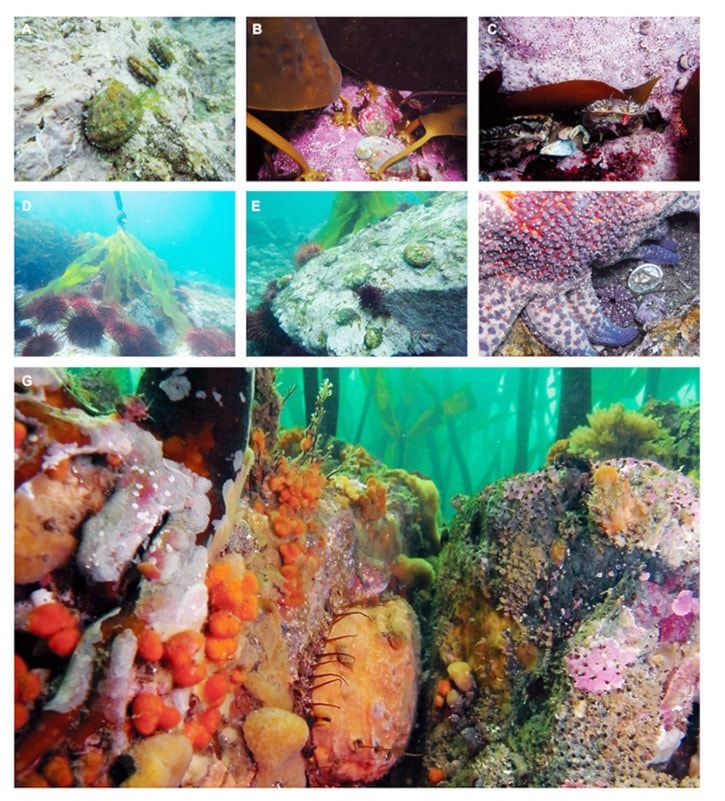A new study suggests abalone won’t have it all bad if sea otters return to Haida Gwaii.
Sea otters eat abalone, and the furry shellfish-eaters are already recovering along the mainland and Vancouver Island coasts, where they were wiped out by the 18th- and 19th-century fur trade.
Despite a 27-year ban on abalone fishing in B.C., there is no sign yet of a similar recovery for northern abalone, which were subject to intense fishing from the 1960s to the 1980s, and are still at risk from poaching today.
While sea otters and northern abalone are both listed as at-risk species in Canada, few ecologists have looked at how the threatened predator and threatened prey might affect each other as they recover in Haida Gwaii and neighbouring waters.
Lynn Lee is lead author of a study recently published in the journal Ecosphere that looks not only at sea otters and abalone, but other keys to their survival — sunflower stars, sea urchins, and the shape, depth, waves and kelp forests in their seafloor habitats.
What Lee and her colleagues found is that although sea otters would indeed reduce the number of abalone in Haida Gwaii, the abalone are likely to survive because sea otters also thin out the kelp-grazing sea urchins that behave something like deer of the sea.
“I think the key thing is we can’t look at species in isolation,” says Lee, a PhD candidate at Simon Fraser University who lives in Tlell.
Under Canada’s Species at Risk Act, for example, sea otters are mentioned as a possible threat to the recovery of northern abalone.
But there’s no measure for how much of a threat the otters are, and no accounting for how they might indirectly help abalone by encouraging kelp forests and preying on other predators: octopus, crab, and sunflower stars.
“The law isn’t set up that way,” said Lee, noting that it’s hard to measure just how strong an effect each factor in the ecological picture might have.
That is something the statistical side of Lee’s research aims to do. It shows, for example, that shellfish-gobbling sea otters will likely have three times more power over abalone numbers as anything else in their natural environment.
“I’m hoping that this paper will help us inform management, so we can start building some of those ecological consequences into our recovery plans,” said Lee.
Haida, Heiltsuk, and Nuu-chah-nulth peoples hunted sea otters and fished abalone for millennia. In California, archaeological records show the rise and fall of red abalone over some 8,000 years.
After sea otters were wiped out by B.C.’s post-contact fur trade, abalone numbers grew much higher. By the 1900s, what commercial fishers took for “normal” was in fact a super abundance of abalone.
The same goes for sea urchins. Lee said anyone diving around Haida Gwaii will see plenty of the kelp clearcuts known as “urchin barrens.”
“What we typically see here is that from the surface you’ll see a lot of kelp along the edges of the islands that have rocky shores,” Lee said.
“That kelp is fairly shallow, and below the kelp line you’ll find the urchin barrens, which are defined by lots of urchins, not a lot of kelp, and lots of that pink encrusting coraline algae that grows on the rock.”

Sea otters were re-introduced to western Vancouver Island between 1969 and 1972, where they now number about 5,000. After spreading north, about 500 now live along the Central Coast, and they are also recovering in southeast Alaska.
By 2009, sea otters were down-listed from “threatened” to a species of “special concern” in Canada.
But despite 17 sightings of what were likely scouting males between 1970 and 2012, there are no mating pairs yet in Haida Gwaii waters.
“We’re surrounded by sea otters, essentially,” said Lee.
“So at some point, when they’ve expanded and decided to move further afield, then they’ll move here. But how long that will take is anybody’s guess.”
In her study, Lee compared sites with and without sea otters on Haida Gwaii, the Central Coast, and western Vancouver Island.
After six years with sea otters around, nearly all the abalone left had gone ‘cryptic,’ meaning they hide in gaps between subtidal rocks. At sites where sea otters had been around 30 years, there were 16 times fewer abalone than those with no sea otters at all.
Likewise, the areas with sea otters grew thicker with kelp — a swaying undersea forest that gives fish and shellfish places to hide and shelter from the waves.
“There’s a lot of polarization and perspectives on whether people would like the otters back or not,” said Lee, whose remaining PhD work will focus more on the socio-cultural side of the issue.
“Nobody has the appetite to re-introduce them actively, but if they come back, they’ll naturally come back as part of our ecosystem,” she added.
“We really need to take this ecosystem-based approach and try to understand as much as we can to make good decisions.”
